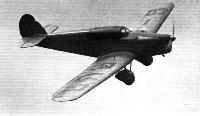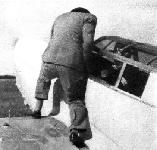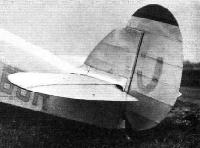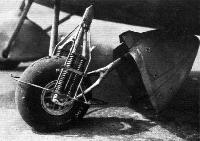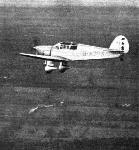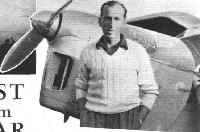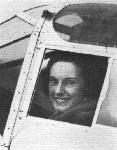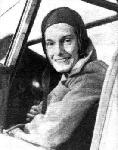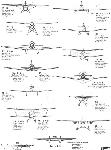
Варианты
- Percival - Gull - 1932 - Великобритания
- Percival - Vega Gull / K.1 - 1935 - Великобритания
- Percival - Proctor / P.28 - 1939 - Великобритания
Percival. Самолеты семейства Gull
Эдгар У. Персиваль построил прототип своего трехместного туристического моноплана Type D.1 Gull в Мэйдстоуне в 1932 году. В том же году в гонке на Королевский кубок самолет показал среднюю скорость 229,7 км/ч. Аэродинамически чистый дизайн привлек внимание, и новая компания "Percival Aircraft Со." выдала субподряд на постройку 24 Type D.2 Gull компании "George Parnall & Со.". На машины ставились двигатели Cirrus Hermes IV и de Havilland Gipsy Major мощностью 130 л. с., а также Napier Javelin III мощностью 160 л. с. Самолеты известны под общим обозначением Gull Four.
В 1934 году компания "Percival Aircraft" открыла в Грейвсенде свою собственную сборочную мастерскую и начала выпускать улучшенную модель Type D.3 Gull Six с двигателем de Havilland Gipsy Six мощностью 200 л.с. Самолет имел более изящное одноподкосное неубирающееся шасси с обтекателями и улучшенную кабину, но сохранил складывающиеся крылья модели Gull Four. В 1936 году компания переехала в Лутон, где был построен 48-й самолет D.3, поставленный компании "Shell" в Южную Африку в октябре 1937 года.
<...>
Описание:
- Percival. Самолеты семейства Gull
- Flight, July 1932
The Percival "Gull” - Flight, November 1932
British Aircraft - Flight, April 1934
AN IMPROVED "GULL" - Flight, March 1935
THE 1935 MODEL "GULL"
Фотографии
-
Aeroplane Monthly 1993-10 / M.Oakey - Grapevine
Регистрационный номер: G-ACGR [4] The Brussels Air Museum’s newly-restored static Percival Gull 4 G-ACGR basks in the sun against the classical backdrop of the city’s Parc du Cinquantenaire, which must be the world’s most impressive aviation museum forecourt.
-
Aeroplane Monthly 1983-11 / Percival Gull Six G-AERD /Preservation Profile/
Регистрационный номер: G-AERD [10], HB-OFU [10] NORMAN PEALING'S photograph depicts the Neil Jensen's ex-Swiss registered Percival Gull Six G-AERD, based at Redhill in Surrey.
-
Aeroplane Monthly 1983-01 / J.Silvester - Percival Aircraft 1933-1954 (1)
Регистрационный номер: G-ABUR [9] Another view of the prototype Gull, taken in 1932.
-
Flight 1932-07 / Flight
Регистрационный номер: G-ABUR [9] THE PERCIVAL "GULL" (HERMES IV): This is a new type, with seating accommodation for pilot and two passengers.
-
Flight 1932-07 / Flight
EFFICIENCY: This front view of the Percival "Gull" helps to explain why the machine has such a high performance.
-
Flight 1932-11 / Flight
THE PERCIVAL "GULL": A private owner's three-seater with Cirrus-Hermes IV engine.
-
Flight 1933-10 / Flight
Регистрационный номер: G-ACJV [3] MISS SOUTHERN CROSS: The Percival "Gull" ("Gipsy Major") used by Sir Charles Kingsford-Smith for his record flight to Australia.
-
Flight 1933-10 / Flight
Регистрационный номер: G-ACJV [3] KINGSFORD-SMITH'S AUSTRALIAN FLIGHT: Sir Charles Kingsford-Smith and his Percival "Gull" ("Gipsy Major"), Miss Southern Cross, in which he is making a flight to Australia.
-
Aeroplane Monthly 1987-03 / K.Durdey - An Australian air knight
Регистрационный номер: G-ACJV [3] Sir Charles Kingsford Smith and his Percival Gull G-ACJV, Miss Southern Cross, in which he flew from England to Australia in 7 days 4hr 44min in October 1933.
-
Flight 1932-07 / Flight
Регистрационный номер: G-ABUR [9] -
Aeroplane Monthly 1984-04 / A.Ord-Hume - Edgar Wikner Percival
Регистрационный номер: G-ABUR [9] The prototype Percival Gull, G-ABUR, during initial trials early in 1932. This aircraft was originally powered by a 130 h.p. Cirrus Hermes IV but for a while flew with a 160 h.p. Napier Javelin III engine which gave a top speed of around 160 m.p.h.
The prototype Percival Gull three seat folding-wing monoplane, G-ABUR, was the first of a line of high performance touring aircraft that culminated with the Proctor. -
Aeroplane Monthly 1983-10 / Skywriters
Регистрационный номер: G-ABUR [9] The flying shot reproduced here, shows ’BUR whilst practising for the 1932 King’s Cup Air Race. It is notable as it shows the aircraft following an extensive (and hushed-up) rebuild at Brooklands prior to the race. This was necessitated by a forced landing (in Scotland I believe) in which the wing was severely damaged. As no works drawings were available, the wings of Hendy 302 G-AAVT were stripped and the structure copied in oder to get ’BUR back in one piece in time for the race.
-
Flight 1932-07 / Flight
Регистрационный номер: G-ABUR [9] A VERY FAST THREE-SEATER: The Percival "Gull" did not get a place in the King's Cup, but it put up a very good performance. The new "Hermes IV" inverted engine gave no trouble whatever.
-
Aeroplane Monthly 1982-07 / R.Riding - The 1932 King's Cup air race
Регистрационный номер: G-ABUR [9] Edgar Percival's Gull G-ABUR, one of the fastest entries, only came 12th with an average speed for the course of 143 m.p.h.
-
Aeroplane Monthly 1980-09 / Personal album
Регистрационный номер: G-ABUV Hermes-engined Percival Gull Four G-ABUV was initially registered to C. S. Napier, in March 1933. In August of that year it passed to Surrey Flying Services and was then sold to M. Maxwell in October 1935. It was during his ownership that the aircraft was lost in a crash at Nice, France, on November 2, 1936.
-
Aeroplane Monthly 1983-01 / J.Silvester - Percival Aircraft 1933-1954 (1)
Регистрационный номер: G-ACAL The Javelin III powered Gull Four G-ACAL was initially owned by W Lindsay Everard but crashed in October 1933 after a life of only a year.
-
Aeroplane Monthly 1983-01 / J.Silvester - Percival Aircraft 1933-1954 (1)
Регистрационный номер: G-ACFY This early production Gull Four became a works communication aircraft for A. V. Roe and Co Ltd, based at Woodford, it was sold abroad in 1937.
-
Aeroplane Monthly 1989-06 / Personal album. Civil
Регистрационный номер: G-ACHM, F-AQLZ Percival Gull 4 G-ACHM was registered in May 1933. Later it was owned by Brian Allen Aviation Ltd and extensively used by journalists to cover the 1935 Italo-Abyssinian war. Here it is named Vigilant and in the colours of the British Air Navigation Company Ltd. In May 1936 the Gull was sold in France where it became F-AQLZ.
-
Aeroplane Monthly 1989-06 / Personal album. Civil
Регистрационный номер: G-ACLG, VT-AFV Percival Gull 4 G-ACLG pictured at Heston while owned by Loel Guinness. The 601 Sqn flying sword motif is carried on the fin. In November 1934 the Gull was sold to Indian National Airways, based at Delhi, becoming VT-AFV.
-
Flight 1934-04 / Flight
Регистрационный номер: G-ACPA SITTING PRETTY: The 1934 Percival "Gull." Note, in this view, the neat installation of the tail wheel.
-
Aviation Historian 23 / E.Martyn - Flying home for the sheep-shearing
Регистрационный номер: G-ACUL [9], ZK-AES [9] Percival Gull Four G-ACUL before it was acquired by Clark to become ZK-AES, the registration it wore for his solo flight home, although it was not officially registered as such in New Zealand until January 1937, probably when its New Zealand C of A was issued. The fuselage was a striking red and the wings and tailplane silver doped fabric.
-
Aviation Historian 23 / E.Martyn - Flying home for the sheep-shearing
Регистрационный номер: ZK-AES [9], G-ACUL [9] The Gull in the overall silver scheme with black cowling and detailing it acquired some time after Clark sold it to New Zealand’s Civil Aviation Dept, Ernie having flown a total of more than 263hr in the aircraft. The Gull was subsequently used "to facilitate inspections by the Air Staff" until it was impressed into military service as NZ572 in November 1939. It was finally damaged beyond repair during a forced landing, the result of engine failure on take-off from Hobsonville, near Auckland, on July 18, 1940. The remains of this historic aircraft were burnt.
-
Aviation Historian 23 / E.Martyn - Flying home for the sheep-shearing
Регистрационный номер: ZK-AES [9], G-ACUL [9] Ernie Clark (second from left) poses with members of the Canterbury Aero Club at Wigram beside ZK-AES. Clark went back to the UK before the outbreak of war and became an RAF officer, flying unarmed photo-reconnaissance Spitfires in France in 1940, before being posted to transatlantic ferrying operations. He transferred to the RNZAF in January 1944 and ended the war with a DFC.
-
Aviation Historian 23 / E.Martyn - Flying home for the sheep-shearing
Регистрационный номер: ZK-AES [9], G-ACUL [9] Following his cigarette and a cup of tea at Omaka, Clark got back into the Gull in front of the gathered crowds and had a local flying club member swing the prop before departing for Wigram at around 1900hr local time. Note the absence of the propeller spinner, which had "cracked to pieces" by the time Clark had reached Karachi two weeks before.
-
Aviation Historian 23 / E.Martyn - Flying home for the sheep-shearing
Регистрационный номер: ZK-AES [9], G-ACUL [9] Clark pilots ZK-AES over Christchurch during a pleasure flight in January 1937, a few months after his epic solo flight from the UK to New Zealand. Although some sources claim that the aircraft was at some point fitted with a Gipsy Six, its official New Zealand documentation clearly marks the Gull as being powered by a “118/122 h.p.” Gipsy Major.
-
Aviation Historian 23 / E.Martyn - Flying home for the sheep-shearing
Регистрационный номер: ZK-AES [9], G-ACUL [9] The Gull attracts official interest during Clark’s stopover at Darwin. Note the Imperial Airways (IA) Armstrong Whitworth Atalanta, G-ABTI, which may have pushed on from its usual Karachi-Singapore service owing to a problem on the Qantas section of the joint lA/Qantas UK-Australia route.
Другие самолёты на фотографии: Armstrong Whitworth Atalanta / A.W.15 - Великобритания - 1932
-
Aviation Historian 23 / E.Martyn - Flying home for the sheep-shearing
Регистрационный номер: ZK-AES [9], G-ACUL [9] The November 25, 1936, issue of Auckland newspaper The Weekly News celebrated the completion of Clark’s flight back home with a full page of photographs of the intrepid aviator’s arrival on New Zealand soil on November 15. Here he is seen being greeted at Blenheim (Omaka) by Marlborough Aero Club’s flying instructor Noel Chandler and President Alexander Macnab.
-
Aviation Historian 23 / E.Martyn - Flying home for the sheep-shearing
Регистрационный номер: ZK-AES [9], G-ACUL [9] Seemingly undaunted by the colossal journey ahead, Ernie Clark poses on the wing of his Percival Gull Four, ZK-AES, before his departure from Lympne airfield for Italy on October 26, 1936. At this point Clark had flown less than 10hr in the aircraft.
-
Aviation Historian 23 / E.Martyn - Flying home for the sheep-shearing
Регистрационный номер: ZK-AES [9], G-ACUL [9] A by-now somewhat weary-looking Ernie Clark is photographed in the cockpit of ZK-AES after his arrival in the dark at Wigram at 2035hr on November 15, having flown for more than 14hr that day. Note the forward section of the extra fuel tank fitted behind the pilot’s seat by Percival, to give the Gull the extra range needed to complete the UK-NZ flight.
-
Flight 1933-07 / Flight
Percival Gull
-
Flight 1934-06 / Flight
A BUSH AERODROME: Native interest in a "Gull" on Bathurst Is., N. Australia. The aerodrome was constructed under the supervision of Mr. F. X. Grell for use of any who may make the Timor Sea crossing and are in need of a "port of call."
-
Flight 1933-12 / Flight
TWO BRITISH LOW-WING MONOPLANES: The "Hawk Special" on the left and the Percival "Gull" on the right.
Другие самолёты на фотографии: Miles Hawk / M.2 - Великобритания - 1932
-
Aeroplane Monthly 1979-05 / Hendon /Gone but not forgotten/ (2)
Hendon aerodrome during the 50 Years of Flying exhibition in July 1951, seen from the North. More than 60 aircraft, spanning 40 years, were assembled in the static park.
Другие самолёты на фотографии: De Havilland Fox Moth / D.H.83 - Великобритания - 1932
-
Flight 1932-07 / Flight
WITH WINGS FOLDED: The trailing edges of the inner wing portions hinge upwards to permit the wings to be folded back. No jury struts are required, the hinges being strong enough to take the weight of the wings. The petrol and oil tanks are housed in the wing and roots respectively.
-
Flight 1934-04 / Flight
A MODERN INTERIOR: Two wide doors are provided for passengers in the 1934 model "Gull." A third door gives easy access to the luggage locker.
-
Flight 1933-07 / Flight
IN THE NICK OF TIME: The Napier "Javelin" engine of Mr. Percival's "Gull" was disinclined to start in Heat 6, but this strong man got it going as the flag fell.
-
Flight 1932-07 / Flight
ACCESSIBILITY: A view of the "Hermes IV" engine as installed in the "Gull." On the right, a view into the cabin, showing the staggered seats.
-
Flight 1932-07 / Flight
AND THE ORTHODOX TAIL: A view of the tail surfaces, which are of a perfectly normal design and construction.
-
Flight 1934-04 / Flight
EN NEGLIGE: Showing the improved wing folding arrangements, part of the fuel system and the contents of one of the spats of the 1934 model Percival "Gull."
-
Flight 1932-07 / Flight
THE UNUSUAL UNDERCARRIAGE: Each wheel is carried on a fork composed of four members, the ends of the axle having their bearings in crossheads. The landing shock is absorbed by the coil springs, and the bouncing is checked by oil dashpots. Our illustration shows the "spat" removed.
-
Jane's All the World Aircraft 1938 / 03 - All the world's aeroplanes
The Percival "Gull-Six" Three-seat Cabin Monoplane (200 h.p. D.H. "Gipsy-Six" engine).
-
Flight 1935-09 / Flight
C. S. Napier takes off with his Percival Gull, Cirrus Major which averaged 133.5 rn.p.h. in the final.
-
Flight 1937-10 / Flight
Регистрационный номер: G-ADPR [16], AX866 [16] A dull afternoon greeted Miss Batten on arrival at Lympne. Her Gull is here seen over Kent en route for Croydon.
-
Aeroplane Monthly 1988-08 / A.Henshaw - Miles for the Cup! (2)
Регистрационный номер: G-ADFA Peter Mursell's Gull (Gipsy Six), flown by Gardner, of the Redhill Club, into seventh place.
Charles Gardner in the Percival Gull G-ADFA. -
Flight 1935-03 / Flight
Flying at 50 m.p.h.: The "Gull" with split trailing-edge flaps down.
-
Flight 1935-03 / Flight
The 1935 "Gull": Note the new windscreen, which has been found to shed the rain and leave the view unimpaired.
-
Flight 1937-05 / Flight
Mr. H. L. Brook came from the Cape in 4 days by Percival Gull
-
Flight 1936-08 / Flight
OPENING UP AFRICA. Mr. K. W. Brett, who set off from Cairo last Sunday in the Shell company's Percival Gull (seen in the photograph) for a six weeks' tour of Africa. He is to carry out preliminary survey work for aircraft refuelling stations in various parts of Africa, including those on the probable track of the West African Imperial Airways service. In company with M. Vuillemin of the Shell Company in Algiers, he will also inspect sites for stations in the Sahara, Nigeria, and French Equatorial Africa.
-
Aeroplane Monthly 1988-07 / A.Henshaw - Miles for the Cup! (1)
Регистрационный номер: G-ADOE Caryl Napier and Flt Lt E. C. T. Edwards discuss a point in front of Percival Gull G-ADOE.
-
Aeroplane Monthly 1984-09 / R.Percival - A portrait of Percival
Edgar Percival at the time of his record dash from Gravesend to Oran.
-
Flight 1935-04 / Flight
GETTING TOGETHER: Capt. J. C. Hargreaves, Mr. L. P. Hirsh, of Airports, Ltd., Mr. E. W. Percival, designer of the 1935 "Gull" seen in the background, and Mr. R. L. Preston, snapped at Heston recently.
-
Flight 1936-10 / Flight
The floodlit start from Lympne before dawn on Monday of last week.
-
Flight 1935-06 / Flight
Capt. Percival leaving Gravesend at 1.30 a.m. He reached Oran at 8.40 a.m., left at 11 a.m., and reached Croydon at 6.20 p.m.
-
Aeroplane Monthly 1988-07 / A.Henshaw - Miles for the Cup! (1)
The Hatfield sheds filled with competitors’ aircraft, mostly Miles Hawks and Falcons.
Другие самолёты на фотографии: Miles Falcon M.3 / Hawcon M.6 - Великобритания - 1934Miles Hawk / M.2 - Великобритания - 1932
-
Flight 1935-09 / Flight
Toeing the line on Friday. In the foreground, on the left, is Diana Mary Williams' Percival Gull, piloted by T. W. Morton; on the right is A. C. W. Norman's Miles Hawk.
Другие самолёты на фотографии: Miles Hawk / M.2 - Великобритания - 1932
-
Flight 1936-05 / Flight
A HUMAN HORSESHOE greets Mrs. Amy Mollison's Gipsy Six Percival Gull at Croydon on her triumphant return from the Cape.
-
Flight 1935-03 / Flight Advertisements
Регистрационный номер: G-ADEP [2] -
Flight 1935-03 / Flight
Регистрационный номер: G-ADEP [2] The modern trend in cabin and open types is illustrated in this type, the Percival Gull.
-
Aeroplane Monthly 1983-01 / J.Silvester - Percival Aircraft 1933-1954 (1)
Регистрационный номер: G-ADEU, F-AQNA Percival Gull Six G-ADEU remained with Percival Aircraft until 1938 when it was sold in France as F-AQNA.
-
Мировая Авиация 64
Регистрационный номер: G-ADPR [16], AX866 [16] 11-13 ноября 1935г.: Джин Баттен стала первой женщиной, совершившей одиночный полет через Южную Атлантику, пролетев на самолете Percival Gull Six (G-ADPR) "Jean" из Лимпна (Англия) в Натал (Бразилия) через Тиес (Сенегал). Завершив полет за двое суток 13 часов и 15 минут, Баттен на сутки побила рекорд, установленный Джимом Моллисоном 6 февраля 1933 года.
-
Jane's All the World Aircraft 1980 / Encyclopedia of Aviation - Aircraft A-Z - v5
Регистрационный номер: G-ADPR [16], AX866 [16] Percival Gull Six.
-
Мировая Авиация 211
Регистрационный номер: G-ADPR [16], AX866 [16] Здесь можно увидеть, наверное, самый известный из самолетов Gull Six - он служит и до сих пор. В 1936 году летчица Джин Баттен установила на нем рекорд во время перелета из Великобритании в Новую Зеландию.
-
Aeroplane Monthly 1990-07 / M.Oakey - Grapevine
Регистрационный номер: G-ADPR [16], AX866 [16] View of Jean Batten's Percival Gull Six G-ADPR, which made its first flight in 20yr from Old Warden on May 25, 1990.
-
Aeroplane Monthly 1990-11 / Percival Gull Six G-ADPR /Preservation Profile/
Регистрационный номер: G-ADPR [16], AX866 [16] Jean Batten en route for Croydon on arrival from Australia on October 24, 1937.
-
Aeroplane Monthly 1990-11 / Percival Gull Six G-ADPR /Preservation Profile/
Регистрационный номер: G-ADPR [16], AX866 [16] -
Мировая Авиация 102
4-7 мая 1936г.: Эми Моллисон на Percival Gull Six выполнила перелет из Грэйвсенда, графство Кент, в Кейптаун, установив новый рекорд на маршруте Великобритания - Южная Африка (3 суток 6 часов 26 минут).
-
Flight 1936-07 / Flight
An example of the Gipsy Six Gull
-
Aeroplane Monthly 1990-07 / M.Oakey - Grapevine
Регистрационный номер: G-ADPR [16], AX866 [16] View of Jean Batten's Percival Gull Six G-ADPR, which made its first flight in 20yr from Old Warden on May 25, 1990. Built in 1932 and presented to the Shuttleworth Collection by the Hunting Group in 1961, the aircraft has just reached the end of a 3 1/2 yr restoration sponsored by Hunting. Following two preliminary flights in the morning, Angus McVitie made the "official first flight" in the afternoon in the presence of personnel from Hunting Engineering Ltd, seen in the picture. After an impressive pre-war record-breaking career, 'PR was impressed into the RAF as AX866.
-
Aeroplane Monthly 1987-08 / L.Curtis - The Flying Duchess (4)
Регистрационный номер: G-ADSG, VT-ALT The duchess's Percival Gull Six, G-ADSG. She bought the aeroplane a month after the Moth Major, in October 1935, and named it Kittiwake. After her death the Gull went to India, where it was re-registered VT-ALT.
-
Aeroplane Monthly 1983-01 / J.Silvester - Percival Aircraft 1933-1954 (1)
Регистрационный номер: AX866 [16], G-ADPR [16] The most famous Gull Six of all was Jean Batten's G-ADPR, still extant nearly 50 years after it was built. During the war the Gull was impressed into RAF service as AX866 and was restored to Percival Aircraft in August 1946. The picture was taken immediately post war at RAF Kemble.
-
Aeroplane Monthly 1990-11 / Percival Gull Six G-ADPR /Preservation Profile/
Регистрационный номер: AX866 [16], G-ADPR [16] G-ADPR as AX866 at RAF Kemble in December 1945, shortly before it was sold back to Percival Aircraft Ltd.
-
Aeroplane Monthly 1983-11 / Percival Gull Six G-AERD /Preservation Profile/
Регистрационный номер: G-AERD [10], HB-OFU [10] This photograph was used on the aircraft's original Certificate of Airworthiness (No.5747). The space for registration letters has been covered over with brown paper.
-
Aeroplane Monthly 1983-01 / P.Jarrett - Grapevine
Регистрационный номер: G-AERD [10], HB-OFU [10] Following its crash at Thruxton on May 31, 1981, Percival Gull Six G-AERD has been rebuilt by Cliff Lovell at Walkridge Farm, and was due to fly in November 1982.
-
Air-Britain Archive 1984-02
Регистрационный номер: G-AERD [10], HB-OFU [10] Ron Souch's G-ABEV (1823) which was a major attraction at the PFA Rally at Leicester 6.7.80 in its first summer season after being rebuilt.
Другие самолёты на фотографии: De Havilland Gipsy Moth / Moth X - Великобритания - 1928
-
Aeroplane Monthly 1983-11 / Percival Gull Six G-AERD /Preservation Profile/
Регистрационный номер: G-AERD [10], HB-OFU [10] -
Aeroplane Monthly 1983-11 / Percival Gull Six G-AERD /Preservation Profile/
Регистрационный номер: HB-OFU [10], G-AERD [10] The Gull Six photographed at Cointreau, Geneva, its home for 40 years.
-
Air Pictorial 1977-09
Регистрационный номер: HB-OFU [10], G-AERD [10] Percival Gull Six HB-OFU back on British soil at the Sywell PFA Rally 2/7/77
-
Air-Britain Archive 1980-04
Регистрационный номер: HB-OFU [10], G-AERD [10] The Gull Six HB-OFU at Sywell 7.77 before becoming G-AERD with Cliff Lovell.
-
Aeroplane Monthly 1983-11 / Percival Gull Six G-AERD /Preservation Profile/
Регистрационный номер: HB-OFU [10], G-AERD [10] Another Sywell guest was Percival Gull Six HB-OFU, one of three surviving examples. It has now returned to Britain after 40 years in Switzerland.
The Gull photographed shortly after returning to England in 1977. -
Air Pictorial 1977-07
Регистрационный номер: HB-OFU [10], G-AERD [10] Delivered new to a Miss Dulaux in Switzerland 14/1/37, Percival Gull Six HB-OFU has just returned to the U.K. with its original markings
-
Flight 1934-07 / Flight
WHEN THE DROUGHT BROKE : The low-wing Monoplane Tendency was not appreciated by everyone.
-
Aeroplane Monthly 1980-02 / Gravesend /Gone but not forgotten/ (7)
An aerial view of Gravesend taken in March 1935. D.H. Moths G-AAVR, G-AACO and G-ABMZ, a B.A. Swallow and a Percival Gull stand in front of the main hangar.
Другие самолёты на фотографии: British Klemm L.25 Swallow - Великобритания - 1933De Havilland Gipsy Moth / Moth X - Великобритания - 1928
-
Flight 1935-03 / Flight
A view showing the trailing-edge flaps.
-
Flight 1935-03 / Flight
"Open House": Note the size of the doors. The smaller door at the back gives access to the luggage locker.
-
Flight 1938-09 / Flight
Flt, Lt. H. J. Wilson was second at 145.1 m.p.h. in a Percival Gull
-
Авиация и Космонавтика 2025-05 / В.Хвощин - Видеть дальше "буратиньего носа" (6)
Регистрационный номер: G-ADPR [16], AX866 [16] Британский гоночный самолет Percival «Gull Monoplane» G-ADPR компании «Percival Aircraft Company», на котором в 1935-1937 годах новозеландская летчица и инженер Джейн («Джин») Гарднер Баттен (Командор ордена Британской империи и первая женщина обладательница золотой авиационной медали ФАИ) выполнила серию дальних перелетов с установлением мировых рекордов. Обратите внимание, что сдвижные тканевые светозащитные шторки установлены не только на верхней части остекления дверей кабины, но и на остеклении позади входных дверей
-
Aeroplane Monthly 1980-02 / Gravesend /Gone but not forgotten/ (7)
Регистрационный номер: G-ADPR [16], AX866 [16] A particularly happy Flight photograph of Miss Batten with her Gull. Note the large auxiliary tank in the cabin. The machine has a range of 2,400 miles.
Miss Jean Batten with her Percival Gull Sir G-ADPR at Gravesend in September 1936. -
Flight 1935-11 / Flight
Miss Batten at the cabin window of the Gull.
-
Flight 1937-10 / Flight
A happy photograph of Miss Batten framed in the cockpit of her Gull. Behind her can be seen the petrol tank which in the tropics became too hot to touch.
-
Flight 1935-09 / Flight
AN OPEN GULL. It will be agreed that this new open-cockpit two-seater Percival Gull is an extremely pretty aeroplane. Built for the Maharajah of Jodhpur, it is fitted with a Gipsy Six engine, electric starting, dual control and special tankage arrangements which give it a range of 800 miles.
-
Flight 1935-03 / Flight
Light and Comfort: A view from above, looking into the cabin.
-
Flight 1935-09 / Flight
Mr. C. S. Napier's Gull (Cirrus Major) flown by Flt. Lt. E. T. C. Edwards had this extra fuel tank in the cabin in place of the third passenger seat.
-
Flight 1935-09 / Flight
C. E. Gardner, in Peter Mursell's Gull, kept his map well under his nose ... and won the Siddeley Trophy.
-
Flight 1933-11 / Flight Advertisements
THE SMITH INSTRUMENT PANEL INCLUDING Altimeter, Air Speed Indicator, Revolution Indicator, Oil Pressure Gauge, Oil Temperature Thermometer, Time of Flight Clock, Fuel Pressure Gauge, Fore and Aft Level, Air Temperature Thermometer, Rate of Climb Indicator, AND TURN & BANK INDICATOR ALSO FITTED "HUSUN" APERIODIC COMPASS
-
Aeroplane Monthly 1989-10 / M.Oakey - Grapevine
Регистрационный номер: G-ADPR [16], AX866 [16] Former Jean Batten Percival Gull Six G-ADPR is nearing completion at Old Warden, following a rebuild by Hunting Engineering Ltd at Ampthill.
-
Aeroplane Monthly 1979-04 / News Spotlight
Регистрационный номер: G-ADPR [16], AX866 [16] The Shuttleworth Collection at Old Warden is a hive of activity. Seen here is Jean Batten's Percival Gull, G-ADPR,on which restoration to flying condition has now begun.
-
Aeroplane Monthly 1990-11 / Percival Gull Six G-ADPR /Preservation Profile/
Регистрационный номер: G-ADPR [16], AX866 [16] G-ADPR after a forced landing in a field at Bepton, Sussex on December 28, 1935.
-
Aeroplane Monthly 1979-11 / Skywriters
Регистрационный номер: G-ACGR [4] Percival Gull IV G-ACGR as it was found in Brussels. Now the property of the Brussels Air Museum, major components are sought, including a Napier Javelin III engine, undercarriage and various fairings and covers. It was once the property of Sir Philip Sassoon, to whom it was registered on May 12, 1933.
-
Flight 1935-06 / Flight
CLAIMING THEIR RIGHTS: An amusing incident at the recent rally of model aero clubs at Sywell Aerodrome. Several petrol-driven models appeared, and the realistic Percival "Gull" in the foreground made the best performance in this section.
-
Flight 1935-08 / Flight
The "Gull" in its finished state. The span is 7ft. 8in., length 5ft. 3 1/2in. and weight with coil and battery, 6 1/2 lb. The engine is a 15C.C. two-stroke.
-
Flight 1935-08 / Flight
Mr. A. E. Morrod's Percival "Gull" without its fabric.
-
Flight 1933-08 / Flight Advertisements
Регистрационный номер: G-ACGR [4] -
Flight 1934-07 / Flight
Регистрационный номер: G-ABUR [9] ACCURATE AND EFFICIENT: Mr. H. Halkos Percival "Gull" model and a detail of the four motors.
-
Flight 1934-07 / Flight
This is how a metal sheet is arranged to act as an air brake on the Percival "Gull."
-
Flight 1934-07 / Flight
LEGS AND SILENCERS: The new undercarriage of the Percival "Gull."
-
Flight 1935-03 / Flight
The "trousered" undercarriage and its details.
-
Flight 1935-03 / Flight
The tail units. Note the castering tail wheel.
-
Flight 1934-10 / Flight
Другие самолёты на фотографии: Bellanca 28 Flash - США - 1934De Havilland Comet / D.H.88 - Великобритания - 1934De Havilland Fox Moth / D.H.83 - Великобритания - 1932De Havilland Leopard Moth / D.H.85 - Великобритания - 1933Fairey Fox - Великобритания - 1925Harkness & Hillier All Australian - Австралия - 1934Lockheed Sirius / Altair 8 - США - 1929Lockheed Vega - США - 1927Miles Falcon M.3 / Hawcon M.6 - Великобритания - 1934Monocoupe 90 / 110 / 145 - США - 1930Northrop Delta - США - 1933Short Scion / S.16 - Великобритания - 1933
-
Flight 1936-05 / Flight
The distribution in the Gull of the tanks which gave a 2,400-mile range.
-
Aeroplane Monthly 1983-01 / J.Silvester - Percival Aircraft 1933-1954 (1)
Percival "Gull" Hermes IV engine
-
Flight 1935-03 / Flight
Percival "Gull" 1935 Model "Gipsy VI" Engine
Тип фотографий
- Все фото (122)
- Цветные фото (2)
- Ч/б фото (96)
- Кабина (5)
- Реставрация (2)
- Обломки (2)
- Модели, рисунки, схемы (15)










